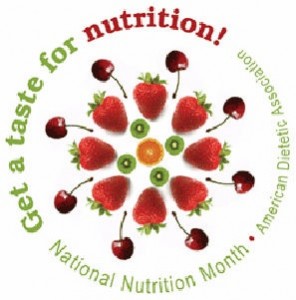 In honor of National Nutrition Month, I would like to help celebrate with diet tips from choose MyPlate. Hopefully by now most of us are aware that the food pyramid is no more and MyPlate has taken its place. www.choosemyplate.gov has many great resources for all stages of the lifecycle, as well as additional resources on eating right on a budget, healthy snacking tips and a diet and physical activity tracker called SuperTracker! So I would like to review the “10 tips to a great plate” from the nutrition education series to promote healthier eating for National Nutrition Month.
In honor of National Nutrition Month, I would like to help celebrate with diet tips from choose MyPlate. Hopefully by now most of us are aware that the food pyramid is no more and MyPlate has taken its place. www.choosemyplate.gov has many great resources for all stages of the lifecycle, as well as additional resources on eating right on a budget, healthy snacking tips and a diet and physical activity tracker called SuperTracker! So I would like to review the “10 tips to a great plate” from the nutrition education series to promote healthier eating for National Nutrition Month.
1) Balance calories. First, you need to have an idea of how many calories you need in a day. To do this you could utilize the SuperTracker function at www.choosemyplate.gov. It is very user-friendly and breaks down food groups and portion sizes for you within your estimated calorie needs.
2) Enjoy your food but eat less. It’s important to pay attention to hunger and fullness cues before, during and after meals. This will help you to eat enough, but not too much. Also, take the time to enjoy your meal by minimizing distractions (TV, computer, etc) and really focus on the smell, taste and appearance of your meal!
3) Avoid oversized portions. Using smaller plates, bowls and glasses is a great way to help you portion control your meals. When dining out, look for the “lighter fare or portion controlled menu” that many restaurants offer.
4) Foods to eat more often. Focus on filling half your plate with vegetables and fruit, about ¼ with lean protein and the other ¼ with a whole grain or starchy vegetable. A serving of low fat dairy is also recommended at each meal.
5) Make half of your plate fruits and vegetables. Make your plate as colorful as possible by using half your plate for fruits and vegetables. Choose red, orange and dark green vegetables such as tomatoes, red peppers, sweet potatoes, spinach and broccoli. Use seasonal fresh fruits as a side dish or part of your main meal.
6) Switch to fat-free or low-fat (1 percent) milk. These choices have the same amount of protein and essential nutrients as whole and 2 percent milk, with lower calories due to less saturated fat content.
7) Make half of your grains whole grains. Boost your fiber intake by substituting whole grain products for more refined counterparts. For example, instead of choosing corn flakes cereal, consider bran flakes to increase fiber and vitamins and minerals. Instead of white bread for sandwiches, choose 100 percent whole wheat bread.
8) Foods to eat less often. Cut back on foods high in fat, added sugars and salt. These will mainly include sugar sweetened beverages, highly processed snack foods and baked goods as well as processed meats (hot dogs, sausage, bacon).
9) Compare sodium in foods. Use the nutrition facts label to compare similar food items to find ones with the lowest sodium content. You can almost always find a “low sodium” or “reduced sodium” version of typical high sodium foods such as soups and frozen entrees.
10) Drink water instead of sugary drinks. Water is naturally calorie-free! Water is the best beverage for daily hydration. Sugary beverages may taste good but they are loaded with calories and actually do not quench thirst but can make you thirstier due to the sugar content.
If you are interested in learning more about nutrition counseling sessions with a registered dietitian at Noble Hospital, please call 413-568-2811 ex: 5671 for more information.
Allison Mitchell RD,LDN, is the Clinical Nutrition Manager at Noble Hospital.

